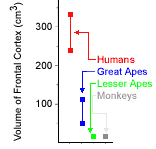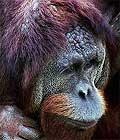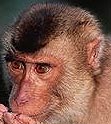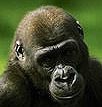| Up Front
About the Frontal Lobe Humans and Great Apes Have Similar Frontal Lobes
|
| Up Front
About the Frontal Lobe Humans and Great Apes Have Similar Frontal Lobes
|
|
March 18, 2002
Scientists from the Department of Anthropology at the University of
California in San Diego and the Department of Neurology at the University
of Iowa compared the cortical volume of the frontal lobe in:
The scientists found that humans had the largest total frontal cortex volume in any of the primates (volume range: 238.8 cm3 to 329.8 cm3). Orangutans and chimpanzees had the next largest volume of frontal cortex, followed by the gibbons and monkeys. However, when the proportion of frontal cortex to the entire cerebral cortex was compared, the values for humans (36.4%-39.3%) overlapped with those of the great apes (35%-38.7%). In other words, the proportion of frontal cortex to the rest of the cerebral cortex in humans and great apes is similar. Both humans and great apes have relatively larger frontal cortices compared to those of the lesser apes and monkeys. The researchers suggest several reasons why their results are different from previous experiments:
| Volume of the Frontal Cortex Relative Size of the Frontal Cortex |
It's Not Just Size!  So, it appears that there are no
differences in the relative size of the frontal cortex in humans and great
apes. Size of the frontal cortex, though, may NOT tell the whole story.
The frontal cortex is a large area with many different functions.
There are many questions about the frontal cortex that remain unanswered: So, it appears that there are no
differences in the relative size of the frontal cortex in humans and great
apes. Size of the frontal cortex, though, may NOT tell the whole story.
The frontal cortex is a large area with many different functions.
There are many questions about the frontal cortex that remain unanswered:
1. Are all parts of the frontal cortex the same in humans and the great
apes? Moreover, the entire cerebral cortex (frontal, parietal, occipital, temporal lobes) of humans is much larger in proportion to body size than that of other primates. This increased connectivity and total cortex size may provide humans with added cognitive abilities. |
 References:
|
| GO TO: | Neuroscience In The News | Explore the Nervous System | Table of Contents |
![[email]](./gif/menue.gif) Send E-mail |
 Get Newsletter |
 Search Pages |